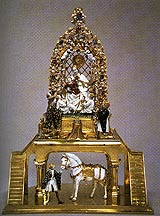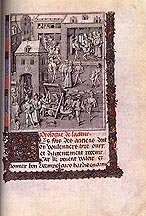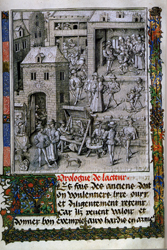Art Home | ARTH Courses | ARTH 214 Assignments
Gift Giving
Excerpts from Brigitte Buettner, "Past Presents: New Year's Gifts at the Valois Court, ca. 1400," Art Bulletin, 83 (2001), 598-625.
p. 598: During the European Middle Ages, gift exchanges or, rather, the broader principle of reciprocity --that is, the obligation "to give, to receive, and to reciprocate," in Mauss's classic formulation --nourished an immense variety of public and personal experiences. It played a vital economic role in ensuring not only the flow of things but also rome redistribution of wealth; it was a social behavior that bound rulers and subjects, husbands and wives and their kin, lovers and beloved. Reciprocity informed medieval religious attitudes, for giving alms or seeking the benevolence of God and his deputy saints through Church donations and prayers were all, in the end, acts of gift giving. As an experience of largesse --the supreme chivalric virtue-- gift giving held a prominent place in the long tradition of ethicopolitical treatises and thus in the norms of conduct of medieval elites. Gifts were used as political weapons to make and unmake alliances, to forge diplomatic ties, to signal dominance; they were deployed to bridge the divide between humans and the divine in charitable giving. And because they tended to be more precious and memorable than everyday objects and carried special meanings, they spoke to people's aesthetic and affective sensibilities. Medieval society afforded countless opportunities for granting presents, extending from basic modes of sociability, as the keeping of an open table, to the more institutionalized forms of social communion, such as weddings, royal and princely entries into cities, embassies, peace agreements, appointments to an office. Gift giving was so much woven into the medieval mentalité that one cannot turn the pages of a literary work, in Latin or in the vernacular, religious or secular, history or fiction, without constantly stumbling over its glorified manifestations....
New Year's day, known at the time as the étrenne, a word derived from the Latin strena, used both for the gifts and the ritual exchange.... When the Valois courts celebrated the New Year in the the late Middle Ages, they (re)inscribed themselves into a long ritual tradition. The custom of marking the New Year by exchanging gifts as a tangible good omen is a seasonal rite observed by most cultures. In the West --where Christmas absorbed most of the rituals previously associated with the New Year only in the late nineteenth century --its roots reach back to the ancient Near East....
p. 600: The étrennes, which allowed nobles regularly to renew their riches as well as to reaffirm, through objects, fundamental familial and social bonds, can be counted among the many cultural innovations formulated within late medieval court society, one that would last well into the modern period....
/p. 603: Riches, in order to be visible, had to be circulated, and the trade volume in luxury items exchanged between courts as well as within a given court was indeed staggeringly high on January I. According to Jan Hirschbiegel, 6,403 actual gifts are recorded for the period between 1381 and 1422 at the Valois courts, a figure that must in reality have been substantially higher if one takes into account the gaps in the surviving documentation. The Burgundian duke Philip the Bold spent on average 6.5 percent of his yearly budget on New /p. 604: Year's gifts. More concretely, in 1404, Louis, Duke of Orléans, disbursed the huge sum of 19,000 livres to buy his étrennes, which included gold images, gems, a great many hanaps (drinking vessels), and two hundred golden hats fashioned like helmets. Or, to give yet another measure, between 1401 and 1416 (the dates of his first and last inventory), Jean de Berry, generally held to be the quintessential art patron, purchased and commissioned for himself only about 119 objects, compared to the 358 that he received as gifts from as many as 136 individuals, more than half of which were given at the étrennes; he, in turn, distributed only some 231 gifts, thus making a very good deal.
What were the kinds of things that the Valois deemed to be suitable as New Year's presents? Perhaps somewhat unexpectedly, manuscripts were seldom used on this occasion between exchange partners of the same social standing -- none, for instance, between two of the most assiduous practitioners of New Year's gifts, the brothers Jean de Berry and Philip the Bold.... By and large, manuscripts featured in asymmetric relationships, for the most dedicated donors of manuscripts were courtiers, presumably those with a literary bent. In addition to a prelate like Martin Gouge, we find secretaries and librarians, among whom Gilles Malet, royal librarian and maistre d'hôtel, is the best known; authors, chief among them Christine de Pizan...; or merchants involved in the book trade, such as Jacques Raponde.
Members of the upper nobility were much keener on what art history has long pushed to the margins --the so-called decorative, minor, or applied arts. In this period, they occupied very much the center of aesthetic appreciation and social value. Categorized as joyaux (jewelry, jewels) and vaisselle (plate), these valuables were destined to adorn bodies, rooms, and tables: in other words, they were worn and used instead of being simply displayed. Necklaces, pendants, brooches, cloak clasps, or rings decorated with pearls and precious stones (above all, the pale variant of rubies known as balas) and figures coated in enamel were prized as étrennes. Made of gold, silver, or gilded metals, intricate table fountains, simpler hanaps, cups, ewers (aiguières), bowls, and other types of drinking and serving vessels appear by the hundreds as well. So do flasks (flagons), used for a variety of purposes, including to hold perfume, which could also be dispensed in the popular ball-shaped pomanders (pommes d'ambre) and musk-balls. Some of these objects, mainly the drinking vessels, referred to the particular occasion on which they were given by sporting inscriptions, such as "a bonne estraine" (for a good New Year). Particular significance was attached to saltcellars, for salt, though a basic ingredient in medieval cooking, also had propitiatory associations. Salts made in imitation of animals were especially favored: Jean de Berry had on one in silver "in the fashion of an ostrich, with a belly of pearl-shell, and seated on a terrace of silver-gilt enameled with green," which was given to him by a son-in-law as an étrenne in 1411, while Philip the Bold offered one with a movable cover in imitation of a Book of Hours to his wife Margaret of Flanders.
A beautiful small salt made in the mid-fifteenth century is still on view at the Musée du Louvre. Composed of a lustrous agate bowl set in a heavy gold mount, it rests on an intricately carved architectural base decorated with pearls and gargoyles and urinating children in white enamel. Though diminutive is size, this object responds to the chief criterion that singled out prestige objects. Plate and joyaux were to be made of expensive and rare materials, often combined in a technically challenging and aesthetically complex fashion, insofar as material and status mutually confirmed each other.... It would be misguided, however, to assume that material worth and artistic intricacy were the only yardsticks by which to measure an ambitious present. Gifts of modest worth could be treasured just as much when they exhibited ingenuity; wit and cleverness were after all highly prize qualities in the courtly value system as a whole. Ingenuity was what transformed nature into artifice and converted what was familiar into something new, into something estrange, one of the four categories that Christine de Pizan uses to determine the /p. 605: merit of a gift....
Striking this this regard is the tabernacle now known as the Goldene Rössl. Unquestionably the most prominent among the handful of surviving peices made about 1400, it has been kept since 1509 in the abbey church of Altötting in Bavaria. As far as is known, this "image of Our Lady who /p. 607: holds her Child seated in a garden" (transformed into a reliquary in the eighteenth century) is the lone surviving étrenne aside from the manuscripts. It was presented on New Year's Day 1405 by Isabeau of Bavaria to her royal husband Charles VI, only to be pawned, along with other precious objects, in that very same year to pay the arrears on the sum pledged to Isabeau's brother Louis of Bavaria, for his yearly pension and his wedding to Anne of Bourbon. Superb in its "surplus visibility," the Goldene Rössl" would have been appreciated as a goldsmith's tour de force, combining gold, silver, and silver-gilt. Particularly noteworthy is the skilled use of the then new and challenging technique of émail en ronde bosse, in which the cast figures and elements of the decor were coated with a layer of enamel of differing degrees of translucency, ranging from opaque white to a transparent and costly red, defined in sources as rouge cler. The piece has recently been painstakingly restored to its former splendor, and one can now at least visually experience its sensuousness and marvel at the large rubies and sapphires and pearls set into the ornate trelliswork that frames the Virgin and Child, or at such exquisite details as the delicately rosy cheeks of its figures. Charles, in knightly garb, is flatteringly inserted on the elevated terrace above the page guarding the horse from which he appears to have just dismounted. The king is separated from another knight, who holds his crowned helmet by a prie-dieu covered with a drapery whose deep folds are enlivened with fine scrollwork made by pricking the surface with little dots (pointillé)-- again an innovative technique in the metalworker's idiom. The prie-dieu supports a tiny open book, with covers and clasps in gold and pages in silver, presumably a Book of Hours from which the king has lifted his eyes to contemplate the object of his devotion. The vision of the Virgin is mediated by three childlike saints, John the Evangelist, John the Baptist, and Catherine, who gives a gift, the ring sealing her mystical union with Christ. Commenting on the curious decision to depict Saint Catherine at such a tender age, Willibald Sauerländer has proposed that taken together the three saints allude to two children (out of twelve) born to Isabeau and Charles in the years before this piece was completed: Catherine in 1401, and Jean in 1398. And he has further sensitively discussed the fairytale atmosphere of the Goldene Rössl, with a king portrayed as a dashing courtly hero, the opposite of the real Charles, who in these years of evewr fiercer onsets of his illness turned periodically into an incontinent, vulgar, dirty, and physically violent being. This consummate object is in sum a gift with a plea, a poignant instance of a "gift for," in which gift and return, demand and response, are inextricably linked, not least in the fact that Charles, the recipient, is made to kneel in a donor stance vis-à-vis the Virgin and Child....
p. 609: One of the most eloquent images showing the interactive nature of court culture and gift giving is the famous miniature painted about 1409 by the Boucicaut Master (or the Mazarine Master) that graces a political compilation written by Pierre Salmon. In it a rather stiff Charles VI, as if impaled on his fleur-de-lis covered throne, accepts the book tendered by his secretary. Though pushed to the left, king and author, larger in scale and higher on the picture, are emphatically offered to the gaze of the nearby courtiers and, through the wide frontal opening, to the beholder. The central transaction is thus singled out by dint of a "surplus of visibility," and that is crucial, for full visibility was the precondition for the ritually correct giving of gifts. All the more noticeable, then, is the way in which Jean de Berry, wearing a rich, black houppelande embroidered with golden swans, unceremoniously turns his back to the king and the central exchange in order to contemplate a bejeweled pendant worn by another courtier. This shrewd comment on the old duke's legendary rapacity in an otherwise rarefied atmosphere is the king of catchy detail, like the depicted book in the Livre des merveilles frontispiece painted by the same illuminator, that would have delighted the viewer.
The artist has perfectly captured the quasiliturgical nature of court culture --a culture in which seeing and being seen were of paramount importance. The court emerges as a metaspectacle, in which each participant, at the same time spectator and actor, is invited visually to assess all others. By sprinkling his image with courtiers who walk in all directions and look out from windows and over the rooftops, the illuminator reinforces the notion that the court was a realm of both different kinds of looking and competing visual claims. The bystanders also imaginarily expand the scene beyond the picture frame: it is as if the gift, dropped like a stone, rippled from the inner court to the outer household and, beyond, to the city of Paris. At the same time, the busy activity in the courtyard and outside the walls evokes the tenet in French royal ideology that encouraged kings to be visible to their subjects. That is why royal and princely residences around 1400 remained quite permeable to commoners, who could enter their courtyards, though they had to stop short of penetrating the semiprivate sphere where the presentation of the book is taking place, a space whose access is here guarded by the resolute doorkeeper, a huissier dressed in the royal livery, a verge in hand.
Because of
the miniature's relative topographical realism, the painted architecture is
generally thought to correspond to an actual royal palace in Paris, the Hôtel
Saint-Pol, favorite royal residence under Charles V and Charles VI. Adjacent
to the newly erected stronghold of the Bastille (in which many of the most
important objects of the royal collection were housed), the Hôtel Saint-Pol
was dismantled from the sixteenth century onward, and its specific layout
was not recorded. We do know, however, that it was exceptionally large and
comfortable, and composed of an irregular collage of discrete buildings, connected
through galleries, gardens, and courtyards. As implied by the miniature, the
king's apartments were situated close to the main portal, while those of the
queen, about half the size of her husband's, were further away toward the
Seine, both being completely independent, closed off, if one wished, by heavy
doors (and with the progression of Charles VI's malady, Isabeau wished to
do so ever more). 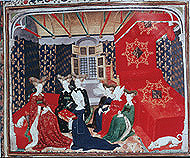 We
may be looking at the Queen's apartment in the presentation scene that opens
the manuscript of her collected works that Christine de Pizan offered to Isabeau
about 1410. Boldly occupying center stage, the writer wears the habitual blue
dress and imposing headgear that identify her in authorial miniatures, while
the recipient's facial features are sufficiently individualized to make her
as recognizable as her husband is in the Salmon illustration. Because it is
now such a familiar image, reproduced on postcards, posters , and other products
of museum gift shops, one can easily forget how strange, indeed, estrange
an experience it must have been when opening a book to be greeted by an all-female
presentation scene, one for which there were no immediate precedents.
We
may be looking at the Queen's apartment in the presentation scene that opens
the manuscript of her collected works that Christine de Pizan offered to Isabeau
about 1410. Boldly occupying center stage, the writer wears the habitual blue
dress and imposing headgear that identify her in authorial miniatures, while
the recipient's facial features are sufficiently individualized to make her
as recognizable as her husband is in the Salmon illustration. Because it is
now such a familiar image, reproduced on postcards, posters , and other products
of museum gift shops, one can easily forget how strange, indeed, estrange
an experience it must have been when opening a book to be greeted by an all-female
presentation scene, one for which there were no immediate precedents.
Although
in hindsight the two miniatures read almost like a diptych, one replete with
gender implications, it is more accurate to view the domestic female environment
and the semipublic male realm as a pictorial translation of two different
rooms that could be found in apartments of both women and men. For while Isabeau's
space suggests the semiprivate chamber, known as the chambre de retrait,
or closet, typically furnished with a daybed, Salmon's presentation is taking
place in the chambre à parer, or presence chamber. According
to Mary Whiteley's detailed studies of the relation between space and its
use in late medieval French palace architecture /p. 610:, the layout of a
princely apartment was standard, comprising, at its minimum, this basic unit.
Adopted even in tents and ships, it led into several rooms and closets on
either side, used for sleeping, as wardrobes, to store collections of valuables
and books, and, most intimate of all, as a space for study (estude).
So succesful that it was reiterated without major alterations down to the
eighteenth-century chambre à enfilade, this innovative formula
was apparently inaugurated in the Palace of the Popes in Avignon during the
first half of the fourteenth century. By 1400 this horizontal organization
of rooms was common, offering more comfort besides a more efficient way to
channel the syncopated pulsation of court activities than did the older fomula
of vertically stacked rooms. 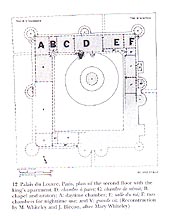 In
the Louvre, for instance, the central donjon built under Philip Augustus,
was transformed into a jail for distinguished prisoners and a storehouse for
the royal coffers when the complex was modernized in the 1360s under Charles
V. Here, too, the king's apartment, along the south wall, was newly organized
around a chambre à parer (D)of considerable dimensions, flanked
on the left by the chambre de retrait (C). Below him, on the second
floor, Queen Jeanne de Bourbon had use of the entire space as well, and even
though her apartment lacked a study and a library, it boasted a comparably
large chambre à parer , the center of /p. 611:her court. (Like
the horizontal succession of rooms, the spatial segregation of wife and husband
became the canonical arrangement from then onward.) Several small stairways,
concealed within the thickness of the walls, permitted internal circulation
between the two apartments, which one could also reach from a majestic external
spiral staircase. Created by the royal architect Raymond du Temple, this grand
viz was one of the Louvre's most innovative features. Enshrined in a projecting
tower, pierced with ample openings enframed by ten genealogical sculptures,
it rose along the entire central axis of the south wall. It is along its now
lost steps that we have to imagine the long procession of household members
and envoys from distant courts, laden with splendid New Year's gifts, working
its way up and down; intermittently seen from the courtyard, past vigilant
doorkeepers, messenger after messenger stopping at the queen's chambre
à parer after having deposited the presents in the room above.
In
the Louvre, for instance, the central donjon built under Philip Augustus,
was transformed into a jail for distinguished prisoners and a storehouse for
the royal coffers when the complex was modernized in the 1360s under Charles
V. Here, too, the king's apartment, along the south wall, was newly organized
around a chambre à parer (D)of considerable dimensions, flanked
on the left by the chambre de retrait (C). Below him, on the second
floor, Queen Jeanne de Bourbon had use of the entire space as well, and even
though her apartment lacked a study and a library, it boasted a comparably
large chambre à parer , the center of /p. 611:her court. (Like
the horizontal succession of rooms, the spatial segregation of wife and husband
became the canonical arrangement from then onward.) Several small stairways,
concealed within the thickness of the walls, permitted internal circulation
between the two apartments, which one could also reach from a majestic external
spiral staircase. Created by the royal architect Raymond du Temple, this grand
viz was one of the Louvre's most innovative features. Enshrined in a projecting
tower, pierced with ample openings enframed by ten genealogical sculptures,
it rose along the entire central axis of the south wall. It is along its now
lost steps that we have to imagine the long procession of household members
and envoys from distant courts, laden with splendid New Year's gifts, working
its way up and down; intermittently seen from the courtyard, past vigilant
doorkeepers, messenger after messenger stopping at the queen's chambre
à parer after having deposited the presents in the room above.
The nerve center of a court's ceremonial topography was no longer the great hall, where the low-ranking household members took their daily meals and large feasts and banquets were celebrated, but the chambre à parer. It supplied a more intimate space in which a ruler could dine in relative isolation, entertain privileged visitors, and hold more private court ceremonies, such as the receipt of New Year's gifts. The sharper separation of public and private domains, and hence of types of activities and visibilities, remains in fact another of the lasting contributions of late medieval architectural planning. Contained within the semiprivate boundary of a ruler's apartment and its restricted social sphere, the étrennes found an appropriate frame to champion values of exclusiveness, quality, and refinement. And this is where the étrennes /p. 612:most markedly differed from the public nature of the Roman Kalends, while at the same time departing from coeval ceremonies, weddings, funeral, entries, jousts, and even the more collective rituals of the Twelve Days cycle, which embraced in one festive occasion the entire household and, beyond, the urban space and its denizens; cities and other civic entities, important donors on other ceremonial occasions, pointedly never appear on New Year's gift lists.
Though sparsely
furnished, the chambre à parer provided a specific area --a
thronelike seat or monumental bench set off by a cloth of honor, as seen in
many presentation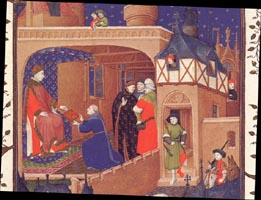 miniatures-- that was strictly off-limits to everyone except the ruler. The
description of King Richard II's presence chamber, in which "le leet
ordeyne and make in his chambir a trone, wherynne he was wont to sitte fro
aftir mete unto euensong tyme, spekynge to no man, but ouerlokying alle menn;
and yf he loked on any mann, what astat or degre that eveir he were of, he
most knele," well articulates the idea of an almost sacramental fulcrum
toward which all gazes and gestures were directed. In addition to the throne,
the chambre à parer might contain a dressoir,
an open cupboard on which to display one's more marvelous possessions, not
unlike the way people nowadays crowd their mantelpieces with Christmas and
New Year's cards as an index to the extent of their social networks.
miniatures-- that was strictly off-limits to everyone except the ruler. The
description of King Richard II's presence chamber, in which "le leet
ordeyne and make in his chambir a trone, wherynne he was wont to sitte fro
aftir mete unto euensong tyme, spekynge to no man, but ouerlokying alle menn;
and yf he loked on any mann, what astat or degre that eveir he were of, he
most knele," well articulates the idea of an almost sacramental fulcrum
toward which all gazes and gestures were directed. In addition to the throne,
the chambre à parer might contain a dressoir,
an open cupboard on which to display one's more marvelous possessions, not
unlike the way people nowadays crowd their mantelpieces with Christmas and
New Year's cards as an index to the extent of their social networks.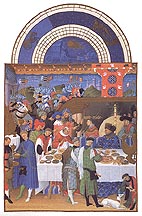 All of this comes vibrantly alive in the opulent miniature
that opens the Très riches heures, in this case a commission
from Jean de Berry to the Limbourg brothers shortly before 1416. The January
page, though not a scene of gift exchange, nevertheless showcases the kind
of banquet that we have to project back into the chambre à parer.
It is a chatty, almost garruloous image, generating ample "surplus visibility"
by cataloguing the accumulation of wealth, whether people or objects, that
Berry needed to assert his prestige, and in so doing reconfirm his dominance
to the viewers of this image --that is to himself, his entourage, and future
onlookers. Clad in a houpplande trimmed with fur and strewn with gold
embroideries and diamonds, the monumental duke is differentiated from his
all-male entourage of court officials and servants by redundant visual signs:
the sophisticated spatial organization that at once detaches him from and
binds him to his surroundings; the full profile view, glorified by the mandorlalike
fire screen; the cloth of honor decorated with his arms (lilies) and his heraldic
animals (bears and swans). Although difficult to perceive in a reproduction,
a miniature gilded bear and swan also perch on either end of the oversize
nef at the center of the table. The nef, a lavish vessel used
both to store trenchers or foodstuff and as a place setting for the most honorer
guest, was a /p. 613: prized New Year's gift. Jean de Berry, for instance,
donated a gold nef, its body decorated with leaf work and six enamels
bearing the arms of France and Berry, supported by four tigers, set with gems
and sixty pearls, to Charles VI as his étrenne of 1405. Other
kinds if vessels are on display on the cupboard to the left. These are handled
by the serving squires, a reminder that medieval people's perception of objects
would have been radically different from our own, limited as we are to experiencing
them, when they survive, by sight but not by touch. In the Limbourgs' miniature,
there is an almost overwhelming sensory overload --things are carried and
examined, food smelled and tasted; when looking long enough, one even starts
to hear the noised made by cutting, pouring, shuffling, and rubbing, or the
clinking of gilded belts and metal vessels, the crackling of the fire, the
dogs barking and people shouting. The human voice is actually present in a
literal way, for the chamberlain standing behind the duke, like a new Saint
John Chrysostome, is expectorating gilded words, "Aproche, Aproche,"
directed to the prelate seated to Berry's right, possibly Martin Gouge. Moreover,
the duke's courtiers' bodies are bedecked in costumes that are given both
an optical and tactile appeal through the addition of gold embroideries, belts,
and jewelry. The entire scene is closed off by a tapestry, which, while it
warms the wall in the back of this Berrichon potlatch, further enhances its
palpably physical quality. Because it depicts an episode from the Trojan War,
one could say that the tapestry foreshadows the anthropological idea that
rituals of conviviality are a social strategy to convert hostile impulses.....
All of this comes vibrantly alive in the opulent miniature
that opens the Très riches heures, in this case a commission
from Jean de Berry to the Limbourg brothers shortly before 1416. The January
page, though not a scene of gift exchange, nevertheless showcases the kind
of banquet that we have to project back into the chambre à parer.
It is a chatty, almost garruloous image, generating ample "surplus visibility"
by cataloguing the accumulation of wealth, whether people or objects, that
Berry needed to assert his prestige, and in so doing reconfirm his dominance
to the viewers of this image --that is to himself, his entourage, and future
onlookers. Clad in a houpplande trimmed with fur and strewn with gold
embroideries and diamonds, the monumental duke is differentiated from his
all-male entourage of court officials and servants by redundant visual signs:
the sophisticated spatial organization that at once detaches him from and
binds him to his surroundings; the full profile view, glorified by the mandorlalike
fire screen; the cloth of honor decorated with his arms (lilies) and his heraldic
animals (bears and swans). Although difficult to perceive in a reproduction,
a miniature gilded bear and swan also perch on either end of the oversize
nef at the center of the table. The nef, a lavish vessel used
both to store trenchers or foodstuff and as a place setting for the most honorer
guest, was a /p. 613: prized New Year's gift. Jean de Berry, for instance,
donated a gold nef, its body decorated with leaf work and six enamels
bearing the arms of France and Berry, supported by four tigers, set with gems
and sixty pearls, to Charles VI as his étrenne of 1405. Other
kinds if vessels are on display on the cupboard to the left. These are handled
by the serving squires, a reminder that medieval people's perception of objects
would have been radically different from our own, limited as we are to experiencing
them, when they survive, by sight but not by touch. In the Limbourgs' miniature,
there is an almost overwhelming sensory overload --things are carried and
examined, food smelled and tasted; when looking long enough, one even starts
to hear the noised made by cutting, pouring, shuffling, and rubbing, or the
clinking of gilded belts and metal vessels, the crackling of the fire, the
dogs barking and people shouting. The human voice is actually present in a
literal way, for the chamberlain standing behind the duke, like a new Saint
John Chrysostome, is expectorating gilded words, "Aproche, Aproche,"
directed to the prelate seated to Berry's right, possibly Martin Gouge. Moreover,
the duke's courtiers' bodies are bedecked in costumes that are given both
an optical and tactile appeal through the addition of gold embroideries, belts,
and jewelry. The entire scene is closed off by a tapestry, which, while it
warms the wall in the back of this Berrichon potlatch, further enhances its
palpably physical quality. Because it depicts an episode from the Trojan War,
one could say that the tapestry foreshadows the anthropological idea that
rituals of conviviality are a social strategy to convert hostile impulses.....
/p. 615: While one could multiply such examples, in the end there would be little variation; they all indicate that the main aim of New Year's gifts...was to maintain and represent social relations. Year in, year out, gifts were pressed into service to enforce the major dividing line that separated court society into distinct if overlapping spheres. There was the inner circle, composed of blood relatives, affines, great officers, and courtiers of high social standing, among whom reciprocity and a certain symmetry in the value of gifts was the rule. Herein, competitive gift giving was instrumental in producing differences in prestige, if not in social rank per se....
The challenge of outdoing one's peers through acts of demonstrative expenditure was fundamentally different from the relationship established with the outer circle, comprising people only loosely connected to a court (such as merchants and artists and writers) as well as hundreds of socially diverse lower ranks of a noble household. In this case, much less was at stake and asymmetry was the rule. Objects of inferior value and artistic elaboration, typically simple jewels with a ruler's insignia or small diamonds, bought in bulk from merchants in precious wares, provided an expendient means through which to distribute gifts to hundreds of people at once. Like liveries, they helped to impart a sense of corporate identity to the socially hereogeneous and potentially explosive court milieu in wich intrigues and factions were endemic....
/p. 616: Gift giving, like most court rituals, adhered to that mute but persuasive grammar made of objects, words, and gestures that ceaselessly spoke of rank and status. No matter their nature, the value of gifts had to be graduated to reflect the social standing of both donor and recipient. In her Livre du corps policie, Christine de Pizan in fact proposes an even finer grid governing the choice of a gift, arguing that it should not only be commensurate with the status of both exchange partners but also take into account the reason for its offering, because there are differences between a gift given for merit, one as a guerdon (reward) and one given out of pure largesse ("franche liberalité de pure courtoisie"). That, at least, was the theory, for in practice the language of gifts must have been a slippery one, as someone could very well swerve from accepted norms. This in turn could endow an object with additional meaning: it could express a particular mark of favor from a ruler, be charged with a specific affective or political meaning, or signal an aggressive social climber who sought to rise above the ruck by disregarding the rules....
/p. 618:
This is not
the place to tackle the tangled issue of the relationship between gifts and
market transactions. One last presentation miniature, taken from David Aubert's
Chroniques et conquêtes de Charlemagne, will help me to suggest
some concluding remarks. Though the manuscripts was offered to Philip the
Good in 1460, 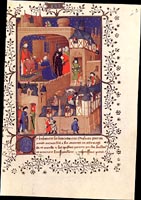 the
grisaille miniature must have been inspired by one painted by the Boucicaut
Master in Pierre Salmon's manuscript some fifty years earlier. Here again,
the main action --Aubert presenting his work to the fashionably attired duke--has
been pushed into the background, and is revealed to us thanks to the same
device of removing the front wall. Lined with several distinct buildings of
a ducal palace, this courtyard, too, bustles with courtiers, all male. However,
at the margins, that is, ingeniously, in the foreground, a variety of townspeople,
both men and women, are selling their wares; they exemplify the prosperity
enjoyed under the duke's "good government," in shapr contrast to
the ensuing cycle of miniatures, most of which linger on gory battle scenes.
Moving in this regard beyond the Salmon frontispiece, the illuminator of this
miniature, Jean le Tavernier, establishes an insightful distinction between
the inside --the courtly world inhabited by horses, falcons, petitioners,
modish denizens, and even a ducal dwarf -- and the outside-- the mercantile
realm stocked with jewelry, exhibited on the stall located inside the stately
protal, with clothes, vessels, and (as I see it) cured fish displayed outside
the wall. Just as obviously, however, the two worlds are conceived as tangent
entities, confirming, in the words of Natalie Zemon Davis, that there always
was a "porousness between the world of commerce and the world of gifts...."
the
grisaille miniature must have been inspired by one painted by the Boucicaut
Master in Pierre Salmon's manuscript some fifty years earlier. Here again,
the main action --Aubert presenting his work to the fashionably attired duke--has
been pushed into the background, and is revealed to us thanks to the same
device of removing the front wall. Lined with several distinct buildings of
a ducal palace, this courtyard, too, bustles with courtiers, all male. However,
at the margins, that is, ingeniously, in the foreground, a variety of townspeople,
both men and women, are selling their wares; they exemplify the prosperity
enjoyed under the duke's "good government," in shapr contrast to
the ensuing cycle of miniatures, most of which linger on gory battle scenes.
Moving in this regard beyond the Salmon frontispiece, the illuminator of this
miniature, Jean le Tavernier, establishes an insightful distinction between
the inside --the courtly world inhabited by horses, falcons, petitioners,
modish denizens, and even a ducal dwarf -- and the outside-- the mercantile
realm stocked with jewelry, exhibited on the stall located inside the stately
protal, with clothes, vessels, and (as I see it) cured fish displayed outside
the wall. Just as obviously, however, the two worlds are conceived as tangent
entities, confirming, in the words of Natalie Zemon Davis, that there always
was a "porousness between the world of commerce and the world of gifts...."
/p. 619: Even had the presentation of the étrennes not been so thoroughly bureaucratized about 1400, the fact remains that they, too, were shot through with monetary concerns. First, the great majority of gifts were purchased (from artists or merchants, the latter often getting them back as securities for the loan of cash). Second, once they were recorded in account books, gifts were assessed against a uniform monetary standard into which they could be converted if necessary....In the end, what account books and inventories categorized as étrennes included, by our reckoning, a variety of transactions: besides gifts and countergifts properly speaking, presents could be equivalent in function to sale transactions, pensions, salaries, and other emoluments, or, indeed, to what we have come to consider as a manifestation of patronage. So the question that needs to be asked is: Why, in the representation of its practitioners, were all these forms of exchange treated as if they were gifts? The hypothesis may be advance that that annual performance of the étrennes and gift giving in general allowed late medieval nobility to counteract the values attendant on the growth of a cash economy by stressing social functions over economic aims. Court society viewed the handling of money, though ever more widespread, as an indecorous gesture, which it affected to believe had not yet infiltrated the most intimate corners of its own world. The fourteenth-century poet Watriquet de Couvin, for instance, thought that minstrels differed from servants in that they received clothes and jewels as opposed to a salary. And a similar sentiment was echoed a century later by the Burgundian court historiographer Georges Chastellain, whose position was secure enough that he could proudly reject monetary retribution for his services: "you have ashamed me by sending me money, which I am not accustomed to taking or receiving, because I do not wish to sell my service to good men for a price."
Christine de Pizan on Gifts
Christine
de Pizan, Livre de trois vertus, I, 19 (pp. 78-79): " The wise
princess wishing to be without reproach will take special care that neither
the vice of meanness and avarice may be seen in her, nor foolish generosity,
which is no less a vice. Therefore, she will distribute these gifts with great
discretion and prudence, for munificence is one of the things that most magnifies
the reputation of great lords and ladies. John of Salisbury proves this in
Polycraticus (book three, chapter twenty-four) by demonstrating that the virtue
of generosity is necessary for those who rule over public affairs. For example,
Titus, the noble emperor, acquired such renown through his generosity that
he was known as the benefit, the relief and the help of all persons. He loved
this virtue of largesse so much that the day he had not given any gift he
could not be happy. In this way he acquired the general favour and love of
everyone....
If any great
lords give her presents or gifts she will reward the messengers so generously
that they will have cause to rejoice. She will give more to foreigners than
to other people so that in their country they may mention her generosity to
their lords. She will want her stewards to deliver the gifts promptly. If
great ladies give her presents, she will send them some of her jewels and
fine things, but more generously. If a poor or simple person does her any
service or kindly presents her with some curiosity, she will consider the
abilities of the person and his or her social position and the importance
of the service, or the value, beauty or novelty of the gift, according to
the case. Whatever the remuneration is, she will give it so abundantly that
the person will rejoice. Furthermore, she will receive the thing with such
a delighted expression that it will be half the payment by itself.
"She will certainly not do what we saw happen once, something that we thought was deplorable at a sophisticated court of a prince or princess. A person was summoned there who was considered wise, so that the court might hear and learn his knowledge. He attended the court several times and everyone felt greatly satisfied with his deeds and his counsel. As a result of his knowledge he did the ruler certain, just, good and laudable services that were worthy of commendation and reward. At the same time another person frequented this same court who had the reputation of being a buffoon and was in the habit of entertaining the lords and ladies with jests and stories of who everyone was doing everywhere and with worthless chatter in the way of mockery and jokes. It was decided that they both be remunerated, and so gifts were given both to the person who was reputed to be wise and who had deserved them because of his knowledge and to the person reputed to be a fool who had done nothing but tell his jokes. A gift was given to this buffoon that was valued at forty écus and to the other a gift worth twelve écus...."
Gift-Giving as a way of out-doing a political rival:
Philip the Good's gifts to Louis XI at his coronation
At the coronation banquet of Louis XI in Rheims, Philip the Good presented the king with a spectacular gift of two large nefs (table centerpieces) rendered in pure gold and decorated with precious stones; two rich drageoirs (sweetmeat dishes), one of them of pure gold, embellished with gems and a golden statue of a maiden representing Love; and jugs, cups, flagons, and large bowls of precious metals. Observers did not miss the statement of the Duke of Burgundy's magnificence which clearly outshone that of the king of France. This was even more evident at a subsequent banquet held by Louis where the gold dishes "all bore the arms of Burgundy, and, just imagine, they were the same vessels which the Duke had given to the King at his coronation in Rheims." Philip the Good thus used the practice of gift-giving as a means of surpassing Louis, his rival. Source: Belozerskaya, Rethinking the Renaissance, pp. 54-55.

